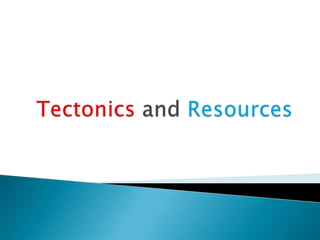
Plate Tectonics and Earthquake Damages
- 3. A tectonic plate is a part of the earth where there is ocean or land. What occurs at plate margins? The following movements may occur at plate margins.
- 4. Oceanic and Two continental plates continental plates move apart forming meet. The oceanic is islands/volcanoes. heavier so it goes down. The place where they meet is called subduction zone. Constructive plate Destructive plate margin margin
- 5. Two continental plates When two plates move go up forming forward making a small mountains. hole where magma passes or just an earthquake. Conservative plate Collision plate margin margins
- 6. Causes: Plate movement, volcano explosion, magma pressure. Damages: Buildings destroyed, chaos collapse, disaster, people die or become homeless, roads collapsed, bridges damaged. Preventions: Evacuation routes, resistant buildings and roads, simulations, having emergency services available, setting up warning information system. Richter Scale: A scale invented to measure the energy realased by earthqueakes.
- 7. Causes: Plate movement, magma pressure, conduction zone. Damages: Several cities destroyed, people killed, Lahar (when in a nevado lava comes out and mixes with snow it becomes water, this water comes down the mountain mixing with ash and mud), ash cause loss of oxygen, houses damaged. Preventions: Setting up monitoring, preparing evacuation plan, training emergency services, post erruption plants. Shapes: Shield volcanoes, which are broad and flat, are less destructive than composite volcanoes, which are cone shaped.
- 8. Causes: Earthquakes near water, magma pressure, big waves, destructive ,margins. Damages: Floods, houses destroyed, wildlife and humans killed. Preventions: Evacuation routes, emergency services ready, post tsunamis plans.
- 9. Why do people live in active areas? Taken from case study, earthquake in Merapi Near volcanoes there is usually fertile soil, heat from the earth usually works for geothermal enery and make geysers for tourism, being one of the most important advantage, tourism also develops in people wanting to climb volcanos and lots of excursions and expeditions.
- 11. Natural resources are things that we can use and are not man made. Types of resources: Renewable: can be replaced in a short period of time. Non-renewable: can’t be replaced. Re-usable: can be used many times. Recyclable: can be changed in form and used again. Sustainable: renewable resources than can disappear if we don’t look for it. Sustainability: how we use resources and care for the enviroment.
- 12. Uses: Electricity: machines, communication, light, education, etc. Transport: tourism, trade,etc.
- 13. Uses: drinking, washing, transport, trade, entertain ment, food, agriculture, electricity. Problems: Waste, contamination, enviromental damage, diseases, floods, drought, wars, conf lict. Solutions: Clean water, save/reuse water, distribute water, canals, better planning.
- 14. Uses: Eat, biomass. Problems: Bad diet, because of biofuels it gets more expensive, bad distribution, desertification. Solutions: For desertification: crop rotation, move animals around, fertilizers, compost, water.
- 15. Types: human and animal waste and trash waste. Uses: Animal waste is used as landfill gas (energy). Trash waste is often recycled.
- 16. Energy: 70% of electricity is hydroelectric, it produces lots of fossil fuels, renewable, clean and cheap energy. Water: Used for hydroelectricity. Problems: Hydroelectricity doesn’t produce as much energy as fossil fuels.